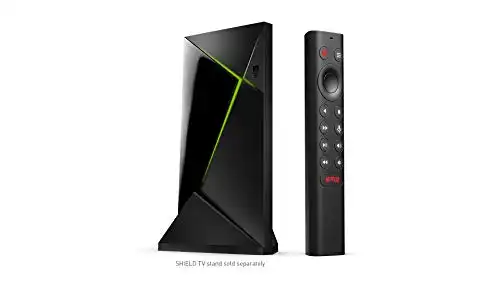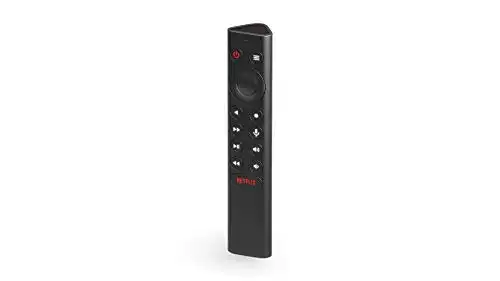Last Updated on January 29, 2024 by Tim Wells

What does the future hold for the NVIDIA Shield TV? It’s an interesting question.
First released in 2015, it’s consistently redefined streaming and gaming experiences for users worldwide.
With no updates on the horizon and NVIDIA’s strategic focus seemingly shifting, many wonder if the Shield TV is being discontinued or is merely on pause?
In this deep dive, we’ll explore the reasons that may have led to this standstill. We’ll examine NVIDIA’s core products and explain the ramifications of the discontinuation of GameStream.
We’ll also cover the NVIDIA Shield TV’s latest major update and explain why, despite its age, it remains a cutting-edge device. Finally, we’ll delve into a possible new NVIDIA Shield TV and give some advice to current users.
Let’s get started.
Nvidia Shield Generations (2015, 2017, 2019, ?)
Nvidia has released 3 generations of Shield devices.

The first generation of the Nvidia Shield TV was released in 2015 and came in two models: the Shield TV with 16 GB of internal flash storage and the Shield TV Pro with 500 GB of hard drive storage. Both models used the Tegra X1 system-on-chip and supported Dolby Atmos and HEVC-encoded video.
The second generation of the Nvidia Shield TV was released in 2017 and had a smaller form factor that dropped microSD and infrared support, but came with an updated controller. The Shield TV Pro model remained unchanged in hardware, except for the addition of a remote control.
The third generation of the Nvidia Shield TV was released in 2019 and introduced two new models: the Shield TV and the Shield TV Pro. Both models used the Tegra X1+ system-on-chip, shipped with Android 9.0 “Pie”, supported Dolby Vision and Dolby Atmos, and included an updated remote control with a built-in lost-remote locator. The Shield TV model had a cylindrical design and 8 GB of internal storage, while the Shield TV Pro model had a similar design to the previous generations and 16 GB of internal storage. The 2019 models also featured a new “AI-enhanced” upscaling system that could upscale high-definition video to 4K resolution using artificial intelligence.
|
4.1
|
4.8
|
3.8
|
|
$149.99
|
$199.99
|
$29.99
|
Unpacking the Competition: The Streaming Device Market
Let’s face it. If you’re anything like me, the streaming device market feels like it’s exploded out of nowhere. We were dealing with a few players one minute, and now, there’s a sea of options, right?
So how does the NVIDIA Shield TV compare against when put head-to-head with others like Roku, Amazon Fire TV Stick 4K, Google Chromecast with Google TV, and Apple TV 4K?
Well, that’s what we’re here to unpack!
Here’s the thing. In this cut-throat market, everyone’s throwing similar products at you.
Typically, the only differences are the price tags and feature sets.
Your typical Roku Streaming Stick+ or the Amazon Fire TV Stick 4K won’t cost you more than $40 to $80.
But the NVIDIA Shield TV starts at a whopping $150 for the base model and $200 for the Pro model.
Ouch, right?
The burning question is this: does the NVIDIA Shield TV justify that premium price tag?
To its credit, it does come with some fancy add-ons like advanced gaming features, native Android apps, and a rather impressive AI-enhanced upscaling.
But if you’re looking for simple, straightforward streaming functionality, that price might have you looking the other way.
Balancing Profit Margins and Operational Costs
Let’s switch gears a bit.
Beyond the consumer’s view, the streaming device market is walking a tightrope. There’s a tricky balancing act between low profit margins and high operational costs.
You see, most streaming devices are sold at or below cost.
It’s like a restaurant offering a low-cost meal and hoping you’ll splurge on drinks and desserts. Manufacturers bank on revenue from subscriptions, advertising, content sales, or data collection to balance the books.
Keeping your streaming device relevant isn’t just about selling devices. It’s about keeping up with the ever-changing demands and expectations of us, the consumers.
This involves constant software, hardware, and content upgrades.
It’s a challenging game, especially for companies like NVIDIA, who don’t have the resources or expertise that dedicated streaming device makers like Roku or Amazon have.
NVIDIA’s Strategic Shift Beyond Streaming Devices
Lately, those resources have been spent elsewhere.
NVIDIA is known globally for its prowess in Graphics Processing Units (GPUs). However, they’ve become a force to be reckoned with in gaming, professional visualization, and Artificial Intelligence (AI) applications.
How does this directly impact a new NVIDIA Shield TV?
NVIDIA is more than just GPUs.
They’re pioneers in the fast-paced, high-demand sectors of AI and data centers, providing cutting-edge hardware and software solutions for many industries.
Healthcare, automotive, robotics, cloud computing—you name it, NVIDIA’s likely there.
These core products are NVIDIA’s cash cows.
They’re highly profitable, strategically valuable, and serve as the company’s key to leverage technological innovations in these sectors.
Then we have the NVIDIA Shield.
Compared to its more profitable siblings, the Shield is a bit of a runt. It’s a relatively minor product line, only contributing a tiny fraction to NVIDIA’s revenue and market share.
Over the past few years, the NVIDIA Shield team was incorporated into the Graphics segment, which develops their GeForce GPUs. To put it into perspective, the Shield TV barely got a mention in NVIDIA’s latest annual report.
The bottom is that the NVIDIA Shield may not be a significant player in the company’s strategy or financial standing.
Reading the Signs: NVIDIA’s Strategic Maneuvers
NVIDIA’s recent moves underscore this focus shift.
First up, their acquisition of ARM, a leading semiconductor company, in September 2020.
ARM chips are commonly found in smartphones, tablets, laptops, and other devices. This strategic move not only gives NVIDIA access to ARM’s extensive network, intellectual property, and low-power computing expertise but also bolsters its influence in the mobile, edge, and IoT markets.
Then there’s the collaboration with Google.
NVIDIA has integrated GeForce Now with Google Chromebooks, allowing users to stream PC games on their laptops without any additional software. This move increases GeForce Now’s exposure to a broader gaming audience and showcases NVIDIA’s cloud gaming technology prowess.
In a nutshell, NVIDIA’s course appears to be moving away from streaming devices, focusing instead on its core products and markets. Not a bad move, if you ask me.
But then again, only time will tell how this strategic shift pans out.
Forgotten in Financial Reports, Marking the End of an Era

If you look at the latest Nvidia financial report, there is no mention of the Nvidia Shield devices. The focus of the company has completedly shifted toward sectors such as data center, gaming, professional visualization, and automotives.
It’s clear that Nvidia is no longer willing to allocate resources and people to the development of a home streaming device. Therefore, it likely marks the end of the era for Nvidia Shield. We do not expect to see a new shield device in the coming years.
Game Over: The Significance of GameStream’s Discontinuation
For those of you who remember the initial launch of the Shield TV, you know that GameStream was the jewel in the NVIDIA Shield’s crown. But those days are gone.
GameStream was not just a feature. It was the NVIDIA Shield’s secret sauce that set it apart from other streaming devices.
GameStream enabled users to play PC games on their TV screens, with the Shield acting as a conduit. Think high-resolution gaming on your large TV screen with a frame rate that left most consoles in the dust.
To sweeten the deal, GameStream offered local co-op and multiplayer modes, along with compatibility with a variety of controllers and peripherals.
But here’s the catch.
In November 2020, NVIDIA announced the discontinuation of GameStream support for new games from December 2020 onwards. And by April 2023, they had deprecated GameStream entirely.
So, what does this mean for you, the Shield TV user?
No more streaming new games from your PC to your Shield TV through GameStream, unless you take the extra step to manually add them to your GeForce Experience library.
This also implies a goodbye to features like automatic game optimization, cloud sync, game highlights, and in-game overlay that GameStream offered.
NVIDIA’s sights are set on GeForce Now, its cloud gaming service that lets you stream games from NVIDIA’s servers, not your PC.
This disappointed users who had GameStream as their go-to for gaming on the Shield TV. Many Shield TV users were upset at the reduced value and functionality of the Shield TV as a gaming device.
Switching to GeForce Now might not be all rosy, either. Some users face hurdles like latency, bandwidth requirements, game availability, or even subscription fees.
But it’s not all doom and gloom.
Some users might find that this change doesn’t affect their gaming experience significantly, especially if they’ve been enjoying other options like native Android games, retro emulation, or Steam Link on the Shield TV.
When Was The Latest NVIDIA Shield TV Update?
The last new NVIDIA Shield TV might seem like ancient history now, as it was unveiled way back in October 2019.
What has happened since then?
Let’s walk down memory lane and see where we are today.
NVIDIA Shield TV Hardware Updates
The 2019 version of the Shield TV and the Shield TV Pro brought to the table several impressive upgrades.
Picture this: a sleeker, smaller form factor, an advanced Tegra X1+ system-on-chip, a revamped remote control, and a nifty AI-enhanced upscaling system.
Both models are powered by the Tegra X1+ processor, boasting up to 25% more oomph than the previous Tegra X1 processor.
Add support for 4K HDR streaming, Dolby Vision, Dolby Atmos, and AI-enhanced upscaling, and you have an all-in-one entertainment powerhouse.
Let’s get down to specifics. With its compact tubular design, the Shield TV packs in 2GB of RAM and 8GB of storage but does away with USB ports. Price tag? A cool $150.
On the other hand, the Shield TV Pro sports the same design as its 2017 counterpart but steps up the game with 3GB of RAM, 16GB of storage, and two USB ports. It also includes added features like Plex Media Server and SmartThings Link support. This one will set you back by $200.
NVIDIA Shield TV Firmware Updates
Since the 2019 release, NVIDIA hasn’t been twiddling its thumbs. Several firmware updates have been rolled out as part of the NVIDIA Shield Experience. Each brings new features and improvements.
PS5 and Xbox Series X controller support, better 4K upscaling quality, enhanced IR volume control, and numerous bug fixes are new.
The most recent update, the NVIDIA Shield Experience 9.1, hit the devices in July 2022.
All in all, NVIDIA is still committed to improving the Shield TV, even if the last major hardware update feels like it was ages ago.
Why We Don’t Need a New NVIDIA Shield
There’s a common assumption that in the tech world, newer is always better.
But let’s be honest, we don’t always need the latest and greatest gadgets. Sometimes, a device can hold its own, despite not being the new kid on the block.
The NVIDIA Shield TV is a classic example of this.
No Need for HDMI 2.1
A common argument is that the Shield TV is missing HDMI 2.1.
Sure, HDMI 2.1, with its higher bandwidth capacity (48 Gbps compared to HDMI 2.0 b’s 18 Gbps), does boast some bells and whistles. It supports higher resolutions, faster refresh rates, and better audio quality.
But is it a must-have for streaming devices?
No.
HDMI 2.1 is definitely a cool feature to have, but it’s not a deal-breaker when it comes to streaming. Most streaming services and platforms still can’t fully utilize the capacities of HDMI 2.1.
4K vs. 8K Support
The Shield TV offers 4K support at 60 frames per second. It doesn’t support 8K, but then again, the streaming universe isn’t ready for 8K just yet.
The reality is that 4K and 8K content is still scarce. Most streaming services and platforms don’t offer content at these ultra-high resolutions.
On top of that, streaming 4K or 8K content requires a lot of bandwidth and storage space. Not everyone has lightning-fast internet or unlimited storage.
For most users, HD or Full HD is more than enough to enjoy their favorite shows and movies.
The State of High-End Audio
Finally, let’s talk about audio.
Yes, the Shield TV does support high-end audio formats like Dolby Atmos, but these formats haven’t yet gained mainstream adoption.
While immersive audio formats such as Dolby Atmos can significantly enhance the viewing experience, the reality is they require a fair bit of setup.
Users need a compatible soundbar or speaker system, a compatible streaming device, and a streaming service that supports the format. That’s a tall order for many users who are not audiophiles.
Most users are perfectly content with standard stereo or surround sound.
All in all, the NVIDIA Shield TV, even with its age, still holds up pretty well in today’s streaming landscape.
It’s proof that sometimes, you don’t need the shiniest new gadget to enjoy a top-notch streaming experience.
The Future of the NVIDIA Shield TV
In this article, we’ve explored various reasons why a new NVIDIA Shield TV may not be on the horizon anytime soon.
From intense market competition and strategic business focus to the discontinuation of GameStream service and the lack of a compelling need for an upgraded Shield, all these factors suggest NVIDIA might not be eager to focus its resources on a new Shield iteration.
This decision, or lack thereof, may leave some Shield TV enthusiasts feeling a bit left out.
Consumers have come to expect regular product updates in the tech world.
Without a new Shield TV hitting the shelves, some users feel that the device is falling behind or even being forgotten by NVIDIA. Many have eagerly awaited enhancements like HDMI 2.1 support, 8K video playback, additional USB ports, or a redesigned remote control.
But as we’ve discussed, these upgrades may not be compelling enough to warrant a new Shield TV model.
Speculating on Shield TV’s Future
As for the future of the Shield TV, I’ve come up with three plausible scenarios based on NVIDIA’s current direction and market trends.
- Continued Support with No New Models: This is the most likely scenario based on the available information. NVIDIA will continue supporting its existing Shield TV models with firmware upgrades and bug fixes but won’t introduce new hardware. This approach would make sense if NVIDIA’s primary goal with the Shield TV was to showcase the potential of its Tegra chips to other industries.
- Phase-out and Focus on Cloud Gaming: Another scenario is that NVIDIA might decide to phase out its Shield TV line altogether, choosing to concentrate more on its cloud gaming service, GeForce Now. Given that GeForce Now is accessible from a broad range of devices, this approach would align more closely with the company’s apparent shift towards cloud-based services.
- A Surprise Release: And, of course, there’s always the possibility that NVIDIA could surprise us all with a new Shield TV model with unprecedented features or capabilities like VR support or a built-in AI assistant. This is an exciting prospect, but it’s also the least likely scenario given the current state of the market and NVIDIA’s strategic priorities.
Regardless of what the future holds, it’s clear that NVIDIA’s Shield TV devices have made their mark.
They have served as a niche product line showcasing NVIDIA’s innovative capabilities, offering unique features and benefits for PC gamers and tech enthusiasts.
Wrapping It Up
As we reach the end of our exploration into the future of NVIDIA Shield TV, it’s important to remember that the device’s future, or lack thereof, shouldn’t eclipse its impressive present. The Shield TV is still a powerful and versatile streaming device with a robust suite of features.
If you’re a satisfied NVIDIA Shield TV user, there’s no urgent need to upgrade or change anything. Enjoy your Shield TV’s features and benefits, and watch for any firmware updates that NVIDIA continues to release.
On the other hand, if you’re dissatisfied with your Shield TV, whether due to performance, feature limitations, or the discontinuation of the GameStream service, there are several potential steps to consider:
- Upgrade to a New Streaming Device: If you want an improved streaming experience, research different streaming device models and brands. Compare prices, features, compatibility, and user reviews to find a device that best suits your needs and preferences.
- Switch Gaming Platform or Service: If gaming is your priority, consider exploring other platforms or services. Whether you’re interested in consoles, PC gaming, cloud gaming, or mobile gaming, each has unique advantages. Evaluate these alternatives based on your gaming preferences, budget, and the availability of the games you love.
- Enhance Your Shield TV: If you’re generally happy with your Shield TV but want to get more out of it, consider adding external storage or using third-party apps or controllers. Adjust your device’s settings or preferences, or troubleshoot any issues to improve its functionality or usability.
While the future of the NVIDIA Shield TV may be uncertain, it’s clear that it continues to be a solid choice for many users.
Regardless of NVIDIA’s plans, it’s worth remembering the Shield TV for what it was – a showcase of NVIDIA’s prowess in GPU technology and a versatile device for media consumption and gaming.
- How to Install Kodi Diggz Xenon Plus & Free99 Build [March 2024] - March 3, 2024
- How to Enable Unknown Sources on Chromecast with Google TV [2024] - October 30, 2023
- How to Install the Seren Kodi Addon [2024] - October 29, 2023




